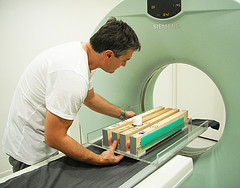Wood gets medical attention
3 May 2013
 Using medical scanners, scientists at Rotorua-based Crown Research Institute Scion have been able to peer inside blocks of wood.
Using medical scanners, scientists at Rotorua-based Crown Research Institute Scion have been able to peer inside blocks of wood.
MRI and CT scanners at Lakes Radiology in Rotorua were used to map the water distribution inside wood from which moisture had been extracted.
Timber engineering technician, Slobodan Bradic from Scion, says that carbon dioxide was used to remove moisture from wood - a process called dewatering. Carbon dioxide has proved to be most effective, and the wood is then open to further modifications such as adding colours and hardening agents.
For Bradic and the Scion research team, a crucial research question remained unanswered - how much water remains inside the wood after dewatering and where is it hiding?
Delia Dephoff, a medical radiation technologist from Lakes Radiology, was both surprised and intrigued when she got the phone call from Scion.
“While our scanners have primarily been used for scanning humans, imaging blocks of wood for research purposes was not something we had considered before. Using these scanners proved to be a massive learning experience for both us and the scientists.
“We were surprised, we figured that chunks of wood should be easier to image than human patients, but we found there were many tricks required to look inside wood”, added Dephoff.
Over the course of several evenings, long after the regular patients had gone home, dozens of wood samples were scanned from pieces of green timber, dewatered wood samples and also wood that had dried using a traditional wood kiln.
Both the MRI and CT scanners were used to view how water was distributed inside the wood. The MRI scanner provided a clearer picture of moisture in wet wood while the CT scanner measures density so was able to detect traces of water left in kiln dried wood.
The results are an impressive series of three dimensional images of moisture patterns inside wood. On a scan, dark areas have a lower density, indicating less water while lighter areas signify more moisture is trapped inside the wood. This knowledge can help Scion’s scientists work out how to dry this wood in the most cost-effective way and potentially open up opportunities to create new applications from wood.
Research of this nature lays the foundation for a new kind of wood that has many high-value commercial applications. This study is still in the research and development phase and a number of studies need to be completed before products can be brought to market.
-ends-
 Using medical scanners, scientists at Rotorua-based Crown Research Institute Scion have been able to peer inside blocks of wood.
Using medical scanners, scientists at Rotorua-based Crown Research Institute Scion have been able to peer inside blocks of wood. MRI and CT scanners at Lakes Radiology in Rotorua were used to map the water distribution inside wood from which moisture had been extracted.
Timber engineering technician, Slobodan Bradic from Scion, says that carbon dioxide was used to remove moisture from wood - a process called dewatering. Carbon dioxide has proved to be most effective, and the wood is then open to further modifications such as adding colours and hardening agents.
For Bradic and the Scion research team, a crucial research question remained unanswered - how much water remains inside the wood after dewatering and where is it hiding?
Delia Dephoff, a medical radiation technologist from Lakes Radiology, was both surprised and intrigued when she got the phone call from Scion.
“While our scanners have primarily been used for scanning humans, imaging blocks of wood for research purposes was not something we had considered before. Using these scanners proved to be a massive learning experience for both us and the scientists.
“We were surprised, we figured that chunks of wood should be easier to image than human patients, but we found there were many tricks required to look inside wood”, added Dephoff.
Over the course of several evenings, long after the regular patients had gone home, dozens of wood samples were scanned from pieces of green timber, dewatered wood samples and also wood that had dried using a traditional wood kiln.
Both the MRI and CT scanners were used to view how water was distributed inside the wood. The MRI scanner provided a clearer picture of moisture in wet wood while the CT scanner measures density so was able to detect traces of water left in kiln dried wood.
The results are an impressive series of three dimensional images of moisture patterns inside wood. On a scan, dark areas have a lower density, indicating less water while lighter areas signify more moisture is trapped inside the wood. This knowledge can help Scion’s scientists work out how to dry this wood in the most cost-effective way and potentially open up opportunities to create new applications from wood.
Research of this nature lays the foundation for a new kind of wood that has many high-value commercial applications. This study is still in the research and development phase and a number of studies need to be completed before products can be brought to market.
-ends-
